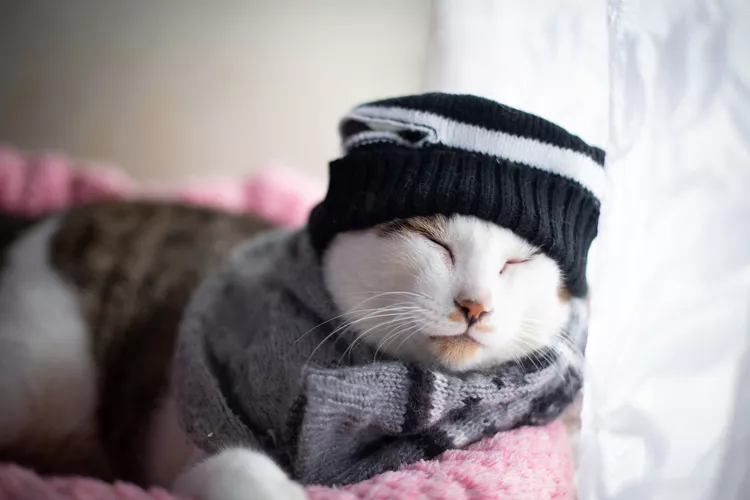How Cold is Too Cold for Cats?

Because cats are notoriously independent and also covered in thick fur, many people mistakenly believe that they are fine to be outdoors in cold weather. It is true that many cats, such as feral and stray cats, live their entire lives outside, though statistics show that these cats will live shorter and harsher lives than your typical house cat. Your indoor/outdoor cat will be relying on you to let them in when they get cold, as they may not have another location to stay warm. Cold weather can be extremely dangerous for our feline friends. So how cold is too cold for cats?
What Temperature Is Too Cold for Cats?
Unfortunately, there is no one perfect answer to this question that will cover all cats and all situations. The lowest safe temperature for a cat will depend on factors such as breed, coat, age, health, and weather factors.
A general rule of thumb is that if it is too cold for you outside, it is too cold for your cat. Cats may experience adverse effects when the temperature outside dips below 45 degrees Fahrenheit for any extended period of time. Even if the temperature is above 45, if there is rain or other inclement weather and the pet is outside for multiple hours, then hypothermia can result. If the temperature goes near or below freezing, 32 degrees Fahrenheit, the cat may suffer from severe hypothermia and even frostbite.
Considerations for Cats and the Cold
Many factors will affect the safety of a cat in the cold. Cats that are old or young will be the most at risk in terms of age. Young cats have less body fat and are less effectively insulated against the cold. Older cats may also suffer from lower percentages of body fat and other health issues affecting their cold tolerance.
The amount of hair or fur that a cat has will also affect its ability to stay warm in cold temperatures. The thicker and denser a cat’s coat is, the more comfortable it will be in the cold.
Living outside is a significant risk factor for everything from injury to illness to parasites. Cats that spend more time outdoors will often have developed locations to hide or nest in when it gets cold, but even then they are still at risk for hypothermia and frostbite. It is not uncommon for veterinarians to see outdoor cats with signs of frostbite on their ears after an overnight freeze. It is highly recommended that all pet cats be kept indoors as it dramatically increases their life expectancy. The average lifespan of an indoor cat ranges from 10 to 20 years, whereas cats who go outdoors typically live only 2 to 5 years.
Humidity, precipitation, wind, and the availability of adequate shelter also play a role in determining the temperature at which an outdoor cat is in danger. More humidity, high wind chill, and snow or ice will all cause more temperature-related issues for these cats. Adequate shelter is imperative and should aid the cat in conserving heat as well as protecting them from the elements. Certainly, it is not recommended to allow any cat out at night due to predators but if this is done, nighttime temperatures should be checked as they are often far colder than daytime temperatures.
Signs Your Cat is Too Cold
Cats are notorious for hiding their illnesses and distress. Frostbite and hypothermia are both risks for outdoor cats that get too cold. It can be challenging to know if your cat is too cold because they cannot tell you.
If your cat is too cold, you may notice the following signs:
- Lethargy
- Dilated pupils
- Slow heartbeat
- Shivering
- Skin feels cold to the touch
- Slow or labored breathing
- Weakness
- Unwillingness to eat or drink
- Hiding
- Dark coloration of the ears or other extremities, indicating frostbite
If any of the above signs are seen in a cat that has been exposed to cold temperatures, it should be brought inside, wrapped in a towel, and taken to a veterinarian immediately. Aggressive or rapid warming can sometimes worsen the situation.
How to Keep Cats Warm in Cold Temperatures
The best way to keep a cat safe from cold temperatures is always to keep them inside your house. If you have a hairless breed, such as a sphynx, warm sweaters, and lots of fluffy blankets will help to keep them warm. Many cats will enjoy lying in front of a sunny window or curling up in a fleecy cat bed to stay warm.
If you are caring for stray or feral cats, you can help them in the cold weather by providing plenty of high-quality, high-calorie food. Staying warm in cold temperatures requires the cat to burn a lot of extra calories. Having a good food source that is readily available and does not require the expenditure of many calories, as hunting would, is very important.
Adequate shelter is a must, and there are many cheap and easy ideas, from dog houses to plastic bin containers, that can be retrofitted for this purpose. The shelter must be placed in an area that is safe from predators and where the cat feels comfortable sleeping inside. Make sure to include some type of warm bedding that will enable the cat to conserve heat.